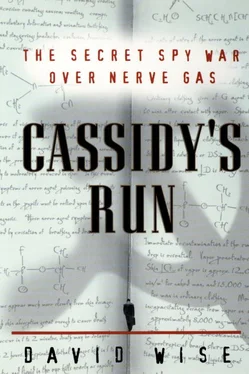There was reason to believe that the material passed to the Soviets by Joe Cassidy was not legally declassified. “If we did declassify a document passed to the Soviets,” said one former counterintelligence official, “we would have to declassify every copy and every other document like it. If the Soviets ever managed to obtain a second copy stamped ‘declassified,’ they’d know we were playing games.”
Even two decades later, with the cold war over, the two Justice Department attorneys were not eager to talk about the PALMETTO case. Martin refused to comment. Tafe, still a lawyer in the internal-security section, declined to speak on the record.
Under the 1972 Supreme Court ruling outlawing capital punishment, there was no death penalty for espionage from that year until 1994, when Congress, in the wake of the Aldrich Ames spy case, restored the penalty if certain criteria were met. (The Supreme Court restored capital punishment in the states in 1976.) Had the Lopezes been convicted of espionage in 1978, they could have been sentenced to a prison term of any number of years or life, but they would not have faced the death penalty.
The espionage statutes generally bar disclosure not of “classified information” but of “information relating to the national defense.” Since 1951, documents have been classified by presidential executive orders, not by law. In practice, since the 1960s, the Justice Department has generally taken the position that data must be classified at the level of secret or above to fall within the definition of “national defense” information. But the statute does not require that the documents be classified. Under the language of the espionage laws, therefore, even if the material left in the rocks had technically been “declassified,” that would not necessarily bar the prosecution of a person who retrieved it and passed it to a foreign power.
The official report that Parker filed afterward, known as a 302 report, summarized the interview: “RIVAS was shown photographs of both he and his wife engaged in espionage activities…. Upon viewing the photographs he stated, ‘You have all of the evidence.’ RIVAS further admitted that he was a Soviet agent…. RIVAS said he decided to work actively against the United States at a very young age. He explained that he could have become a terrorist or do nothing to help his country. But he decided to work for the Soviets in order to make a positive effort.”
The requirement that the FISA court approve break-ins to conduct physical searches in foreign-intelligence cases, except in places such as embassies, was added to the law by Congress in 1994, following the arrest of CIA mole Aldrich Ames. Beginning in June 1993, the FBI wiretapped Ames’s home with a FISA court warrant. On October 9, again with a FISA warrant, bureau agents entered his house to bug the rooms while the Ameses were out of town attending a wedding in Pensacola, Florida. During the same entry, the FBI also searched the premises and downloaded his computer without a warrant, acting on the authority of Attorney General Janet Reno. Had the case gone to trial, Ames’s lawyer, Plato Cacheris, was prepared to test the warrantless search. Ames, however, pleaded guilty to conspiracy to commit espionage, and there was no court case.
Robert L. Keuch, a deputy assistant attorney general in the criminal division during the PALMETTO investigation, says he would take that view. “Once you’ve made a pinhole, I think you’ve entered.”
Both were convicted and fined for violating the civil rights of the persons whose homes were searched; they were pardoned by President Reagan in April 1981.
Humphrey and Truong were convicted of spying for Vietnam. They were each sentenced to fifteen years.
When the CIA began losing agents inside the Soviet Union in 1985, for example, the agency first grasped at the possibility that poor tradecraft by the agents or a code break explained the losses. Only much later did the CIA face up to the probability that there was a mole within, a Russian spy who turned out to be Aldrich Ames. Partly because of the institutional reluctance to think the unthinkable, it took nine years to catch him.
The entertainer, then twenty-six, was billed as Kathie Lee Johnson at the time.
This time Cassidy did not conceal the rock at a drop site, since his instructions did not specify one.
Both the KGB and the GRU recalled anyone who had been pitched by a Western intelligence service, in order to remove the officer from any temptation. Failure to report a pitch was regarded as a very serious offense.
The rock, as big as a house, is located to the north of a playground in an area of the park known as “The Dene,” a British term for a dune or sandy area near the seashore. The rustic shelter that sits atop the rock formation now was not there at the time that IXORA was active.
IXORA told the FBI that he had once sent a signal from the Central Park rock, but that he could not remember the date or the circumstances. Oddly, and for reasons IXORA never explained, he did not transmit from the rock after he received the warning call from Cassidy in May 1972; the watching FBI agents saw him go straight to a dead drop. After Freundlich began cooperating with the FBI in 1978, he was not asked why he had failed to go to the rock; the bureau did not want to compromise Operation SHOCKER by revealing to IXORA that it knew about the call.
The procedure is also known within Soviet intelligence as giving “a sign of life.”
Twenty years later, Sheila Horan, in Nairobi and wearing a white hard hat, became a familiar face to television viewers all over the world as head of the FBI team that investigated the August 7, 1998, terrorist bombings of the U.S. embassies in Kenya and Tanzania.
The ten spies were the six Soviets who handled Joe Cassidy, IXORA’S control, and the three illegals. The six Soviet handlers were Boris M. Polikarpov, Gennady Dimitrievich Fursa, Boris G. Kolodjazhnyi, Mikhail I. Danilin, Oleg Ivanovich Likhachev, and Vladimir Vybornov. The seventh Soviet spy was Nikolai I. Alenochkin, IXORA’s handler. The three illegals were Gilberto Lopez y Rivas, and his wife, Alicia Lopez, the PALMETTOS; and Edmund Freundlich, IXORA.
A CIA report released in 1997 provided further details; the munitions stored at the site included 122 mm “binary sarin” rockets “filled with a mixture of GB and GF.”
“Leader of Protest March Calls U.S. Adviser’s Death ‘Logical,’” United Press International, May 27, 1983. Schaufelberger, thirty-three, of San Diego, was one of six members of a group assigned to El Salvador to coordinate military aid. He was shot in the head four times while waiting in a car for a friend on a college campus in San Salvador.
The newspaper’s account mentioned Lopez as one of four notable foreign speakers.
More recently, word filtered back to FBI headquarters in Washington that Gilberto and Alicia Lopez had divorced.
Associated Press, June 11, 1998.
The Houston Chronicle, July 31, 1998, p. A28.
Читать дальше












